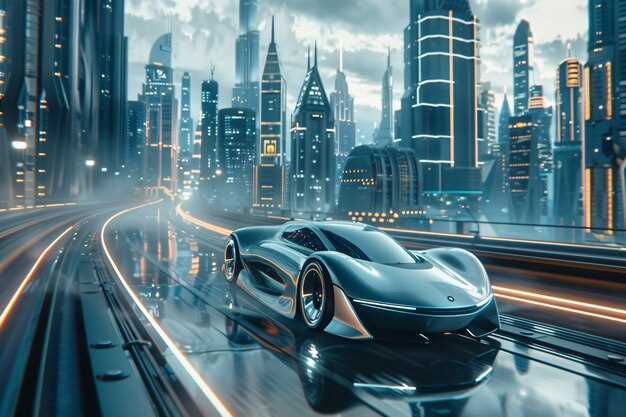
As we approach 2026, the landscape of sports car design is poised for groundbreaking transformations. With the rapid evolution of technology and shifting consumer preferences, manufacturers are exploring a multitude of future trends that promise to redefine our understanding of high-performance vehicles. The integration of smart materials and advanced aerodynamics will not only enhance speed but also improve efficiency, making sports cars more sustainable than ever before.
One of the most significant future trends is the shift towards electrification. As the automotive industry embraces electric power, sports car designers are reimagining traditional concepts. These innovations aim to deliver not just acceleration, but also an immersive driving experience that harnesses the power of cutting-edge battery technology. The challenge will be to balance performance with range, creating vehicles that can cater to both track enthusiasts and daily drivers.
Furthermore, the incorporation of artificial intelligence and connectivity features is set to revolutionize how drivers interact with their cars. In 2026, we can expect sports cars equipped with intelligent systems that adapt to driving styles, road conditions, and even personal preferences. This new wave of technology promises not only enhanced safety but also an unprecedented level of personalization, solidifying the sports car’s status as a symbol of innovation and luxury in the modern age.
Aerodynamic Enhancements: Materials and Techniques

The future of sports car design is heavily focused on achieving optimal aerodynamic efficiency. Enhanced aerodynamics not only improves performance but also increases fuel efficiency. In 2026, innovations in materials and techniques will play a crucial role in shaping the next generation of vehicles.
Advanced composite materials like carbon fiber and graphene will be central to future designs. These materials provide an excellent strength-to-weight ratio, allowing for lighter structures without compromising durability. This reduction in weight contributes significantly to enhanced aerodynamic properties, as lighter cars can achieve higher speeds with less energy expenditure.
Manufacturing techniques such as 3D printing will revolutionize how components are created. This technology allows designers to optimize shapes in ways that traditional methods cannot achieve. Complex geometries can be produced, enabling features like integrated spoilers and air ducts that improve airflow and reduce drag.
Additionally, the incorporation of active aerodynamic elements will become standard in future sports cars. Features like adjustable wings and movable flaps will adapt in real time to driving conditions, optimizing downforce and drag based on speed and maneuverability. This dynamic response will provide drivers with improved control and stability at high speeds.
The integration of computational fluid dynamics (CFD) software in the design process will provide valuable insights into airflow patterns around the vehicle. Simulations will allow designers to assess the impact of different shapes and configurations, leading to more efficient designs that maximize aerodynamic benefits.
In conclusion, the future of sports car design in 2026 will be defined by the strategic use of innovative materials and advanced manufacturing techniques. Coupled with dynamic aerodynamic features, these developments will ensure that performance, efficiency, and aesthetics harmoniously coexist in the next generation of sports cars.
Smart Technology Integration: User Experience and Connectivity
The future of sports car design is increasingly intertwined with advanced smart technologies that enhance user experience and connectivity. As we move toward 2026, designers are focusing on integrating intuitive interfaces and seamless connectivity that redefine how drivers interact with their vehicles.
One significant aspect of this evolution is the implementation of smart infotainment systems, which provide personalized experiences based on user preferences. These systems leverage artificial intelligence to analyze driver behavior, suggesting routes, music, and even optimizing performance settings automatically. Such features not only improve driving comfort but also create a unique connection between the car and its owner.
Moreover, augmented reality (AR) displays are becoming a key component. Future sports cars are expected to feature heads-up displays that project critical information directly onto the windshield, allowing drivers to access navigation, performance metrics, and even real-time diagnostic data without taking their eyes off the road. This design not only enhances safety but also creates an immersive driving experience.
Connectivity is further enhanced with vehicle-to-everything (V2X) technology. This allows cars to communicate with other vehicles, infrastructure, and networks to ensure optimal route planning, collision avoidance, and energy efficiency. The integration of such technology will significantly improve real-time responsiveness and user control, marking a leap forward in automotive design.
Cloud connectivity is another exciting innovation, enabling sports cars to receive over-the-air updates that enhance performance and introduce new functionalities. This evolution ensures that vehicles remain current with the latest technological advancements, making them more efficient and user-friendly over time.
As vehicles become more interconnected, privacy and security concerns also come into play. Future designs will prioritize robust cybersecurity measures to protect user data, ensuring that the pleasure of driving does not come with security risks.
In conclusion, the integration of smart technologies in sports car design for 2026 aims to enhance user experience through personalization, safety, and connectivity. This design paradigm will transform not only how drivers interact with their vehicles but also will elevate the entire automotive industry into a new era of innovation.
Sustainability in Performance: Eco-friendly Powertrains and Practices

The future of sports car design is increasingly focused on sustainability, incorporating eco-friendly powertrains and practices that not only enhance performance but also reduce environmental impact. As automakers look towards 2026, the integration of electric and hybrid technologies is becoming a dominant trend. These innovations promise to deliver exhilarating speed and responsiveness while significantly lowering carbon emissions.
Electric powertrains, powered by advanced battery technology, are at the forefront of this shift. High-performance electric motors provide instant torque, ensuring rapid acceleration and agile handling. Manufacturers are investing heavily in lightweight materials to enhance efficiency, ensuring that the vehicles maintain their performance edge without sacrificing sustainability. The use of recycled metals and composites in chassis design exemplifies a commitment to eco-friendly practices while retaining structural integrity and aesthetic appeal.
Hydrogen fuel cells are also gaining traction as a viable alternative, offering a zero-emission solution that rivals traditional combustion engines in terms of power delivery. This technology allows for quick refueling and longer driving ranges, addressing common concerns associated with electric vehicles. Collaborations between automakers and energy providers aim to streamline hydrogen infrastructure, further supporting the transition to sustainable performance.
In addition to innovative powertrains, manufacturers are adopting sustainable practices across their supply chains. From ethical sourcing of materials to waste reduction initiatives, the entire lifecycle of a sports car is being examined for potential improvements. Carbon-neutral manufacturing processes and efforts to offset emissions are becoming standard practice, making sustainability an integral part of the design philosophy.
The pursuit of scalability in eco-friendly technologies presents both challenges and opportunities. As consumer demand for performance and sustainability grows, automakers are being pushed to innovate continuously. By marrying cutting-edge design with eco-conscious innovation, the sports car industry is set to redefine performance for the future, showcasing that excitement and responsibility can coexist on the roads.



